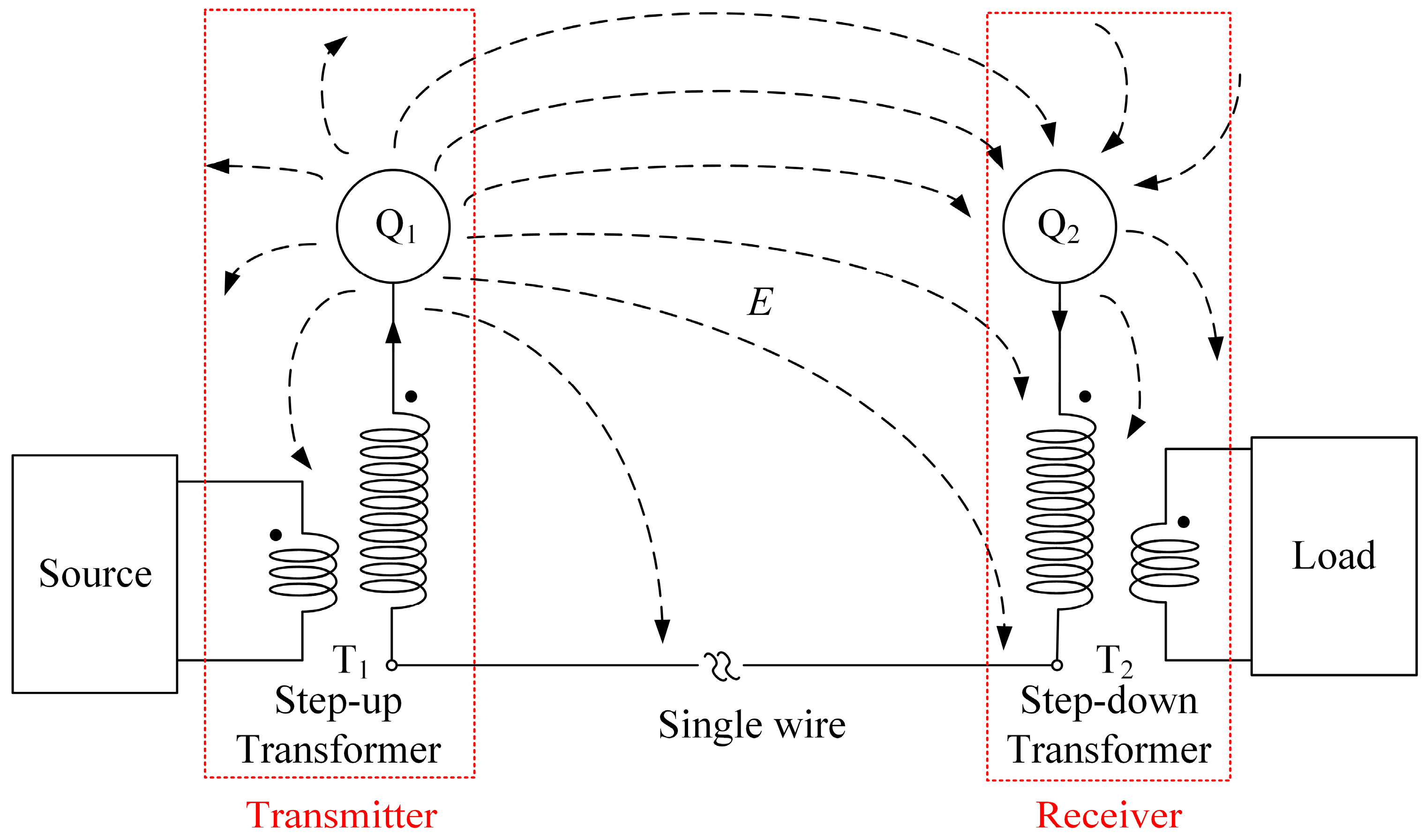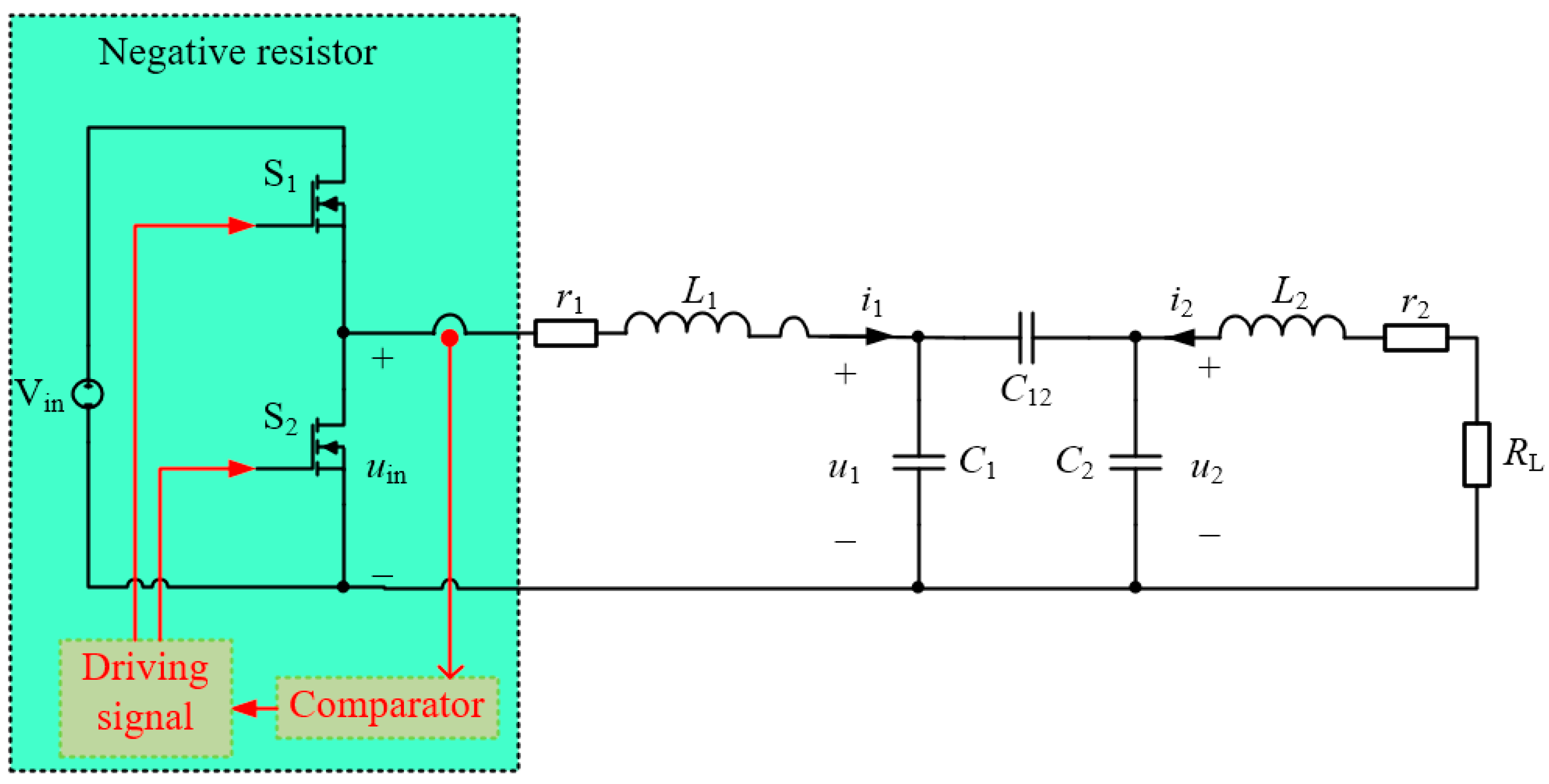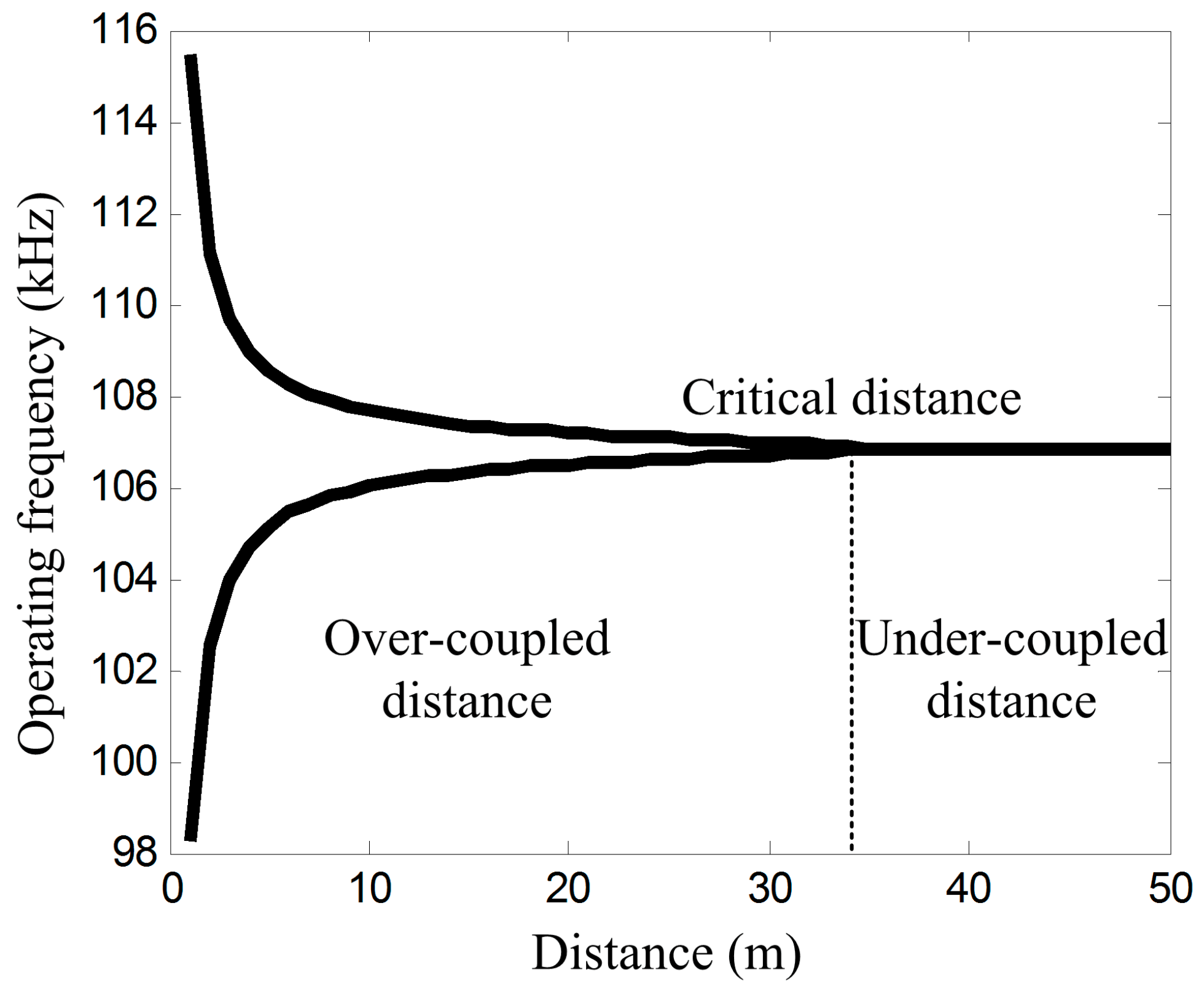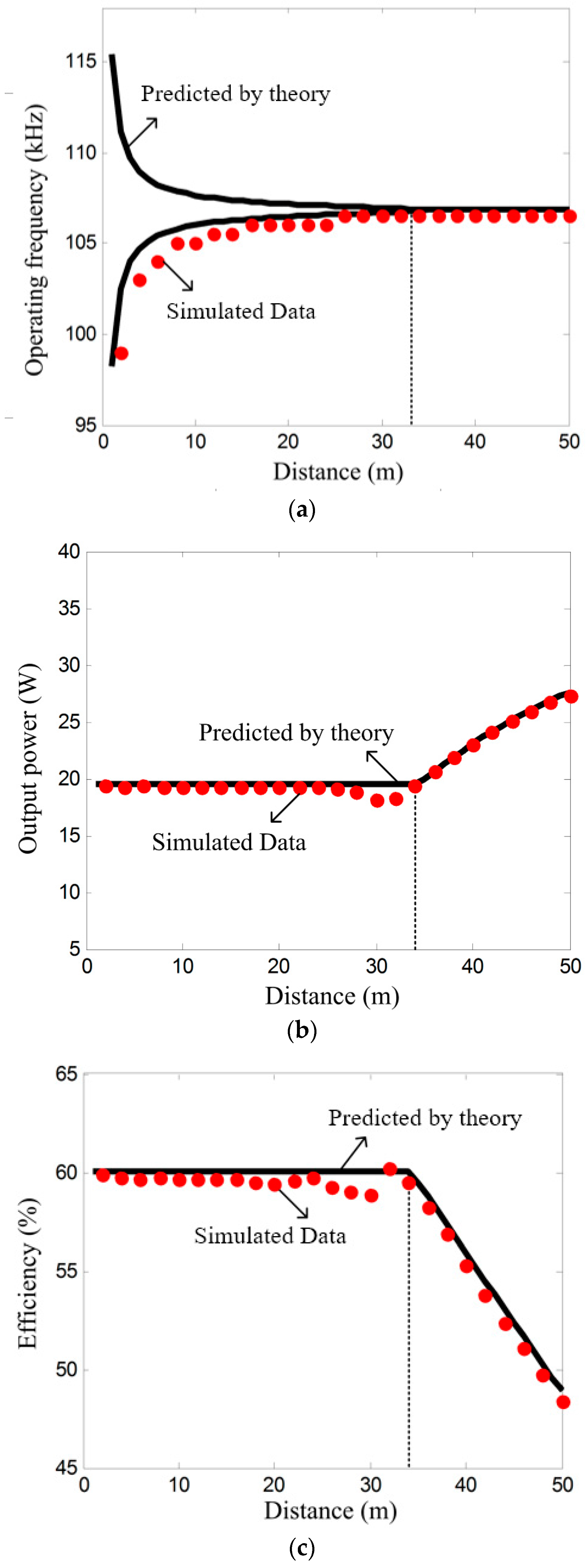Single-Wire Electric-Field Coupling Power Transmission Using Nonlinear Parity-Time-Symmetric Model with Coupled-Mode Theory
Abstract
:1. Introduction
2. System Structure and Modeling
2.1. Discrete State Space Model
2.2. Dynamic Modeling by CMT
3. Analysis of Transmission Characteristics
4. Comparison of Theoretical Analysis and Simulation
5. Discussion and Conclusions
Acknowledgments
Author Contributions
Conflicts of Interest
References
- Marincic, A.S. Nikola Tesla and the wireless transmission of energy. IEEE Trans. Power Appar. Syst. 1982, PAS-101, 4064–4068. [Google Scholar] [CrossRef]
- Tesla, N. System of Transmission of Electrical Energy. U.S. Patent 645,576, 20 March 1900. [Google Scholar]
- Pudur, R.; Hanumante, V.; Shukla, S.; Kumar, K. Wireless power transmission: A survey. In Proceedings of the IEEE International Conference on Recent Advances and Innovations in Engineering, Jaipur, India, 9–11 May 2014. [Google Scholar] [CrossRef]
- Liu, C.; Hu, A.P.; Budhia, M. A generalized coupling model for capacitive power transfer systems. In Proceedings of the IECON 2010, 36th Annual Conference of the IEEE Industrial Electronics Society, Glendale, AZ, USA, 7–10 November 2010. [Google Scholar] [CrossRef]
- Kurs, A.; Karalis, A.; Moffatt, R.; Joannopoulos, J.D. Wireless power transfer via strongly coupled magnetic resonances. Science 2007, 317, 83–86. [Google Scholar] [CrossRef] [PubMed]
- Mcspadden, J.O.; Mankins, J.C. Space solar power programs and microwave wireless power transmission technology. IEEE Microw. Mag. 2002, 3, 46–57. [Google Scholar] [CrossRef]
- Howell, J.T.; O’Neill, M.J.; Fork, R.L. Advanced receiver/converter experiments for laser wireless power transmission. In Proceedings of the Solar Power from Space (SPS04) and 5th Wireless Power Transmission (WPT5) Conference, Granada, Spain, 30 June–2 July 2004. [Google Scholar]
- Covic, F.A.; Boys, J.T.; Kissin, M.L.; Lu, H.G. A three-phase inductive power transfer system for roadway. IEEE Trans. Ind. Electron. 2007, 54, 3370–3378. [Google Scholar] [CrossRef]
- Huang, C.Y.; Boys, J.T.; Covic, G.A. LCL pickup circulating current controller for inductive power transfer systems. IEEE Trans. Power Electron. 2013, 28, 2081–2093. [Google Scholar] [CrossRef]
- Hao, H.; Covic, G.A.; Boys, J.T. Aparallel topology for inductive power transfer power supplies. IEEE Trans. Power Electron. 2014, 29, 1140–1151. [Google Scholar] [CrossRef]
- Choi, B.; Nho, J.; Cha, H.; Ahn, T.; Choi, S. Design and implementation of low-profile contactless battery charger using planar printed circuit board windings as energy transfer device. IEEE Trans. Ind. Electron. 2004, 51, 140–147. [Google Scholar] [CrossRef]
- Adachi, S.I.; Sato, F.; Kikuchi, S.; Matsuki, H. Consideration of contactless power station with selective excitation to moving robot. IEEE Trans. Magn. 1999, 35, 3583–3585. [Google Scholar] [CrossRef]
- Lee, B.; Kiani, M.; Ghovanloo, M. A triple-loop inductive power transmission system for biomedical application. IEEE Trans. Biomed. Circuits Syst. 2016, 10, 138–148. [Google Scholar] [CrossRef] [PubMed]
- Hui, S.Y.R. Magnetic resonance for wireless power transfer. IEEE Power Electron. Mag. 2016, 3, 14–31. [Google Scholar] [CrossRef]
- Thomas, E.M.; Heebl, J.D.; Pfeiffer, C.; Grbic, A. A power link study of wireless non-radiative power transfer systems using resonant shielded loops. IEEE Trans. Circuits Syst. I Regul. Pap. 2012, 59, 2125–2136. [Google Scholar] [CrossRef]
- Celeste, A.; Jeanty, P.; Pignolet, G. Case study in reunion island. Acta Astronaut. 2004, 54, 253–258. [Google Scholar] [CrossRef]
- Yugami, H.; Kanamori, Y.; Arashi, H. Field experiment of laser energy transmission and laser to electric conversion. In Proceedings of the Intersociety Energy Conversion Engineering Conference, Honolulu, HI, USA, 27 July–1 August 1997. [Google Scholar] [CrossRef]
- Kawashima, N.; Takeda, K. Laser energy transmission for a wireless energy supply to robots. Robot. Autom. Constr. 2008. [Google Scholar] [CrossRef]
- Steinsiek, F.; Foth, W.P.; Weber, K.H. Wireless power transmission experiment as an early contribution to planetary exploration missions. In Proceedings of the 54th International Astronautical Congress of the International Astronautical Federation, the International Academy of Astronautics, the International Institute of Space Law, Bremen, Germany, 29 September–3 October 2003; Volume 3, pp. 169–176. [Google Scholar] [CrossRef]
- Hyde, R.A.; Dixit, S.N.; Weisberg, A.H.; Rushford, M. Eyeglass: Large aperture diffractive space telescope. Proc. SPIE Int. Soc. Opt. Eng. 2002, 4849, 28–39. [Google Scholar]
- Tetsuo, N.; Tianhongshu, P.; Yong, L. Great power wireless transmission technology. Electron. Des. Appl. 2007, 6, 42–54. [Google Scholar]
- Mayordomo, I.; Drager, T.; Spies, P.; Bernhard, J.; Pflaum, A. An overview of technical challenges and advances of inductive wireless power transmission. Proc. IEEE 2013, 101, 1302–1311. [Google Scholar] [CrossRef]
- Dukju, A.; Songcheol, H. A transmitter or a receiver consisting of two strongly coupled resonators for enhanced resonant coupling in wireless power transfer. IEEE Trans. Ind. Electron. 2014, 61, 1193–1203. [Google Scholar] [CrossRef]
- Strebkov, D.S.; Avramenko, S.V.; Nekrasov, A.I. Single-wire electric power system for renewable-based electric grid. New Energy Technol. Mag. 2001, 20–25. Available online: http://ptp.irb.hr/upload/mape/kuca/07_Dmitry_S_Strebkov_SINGLE-WIRE_ELECTRIC_POWER_SYSTEM_FOR_RE.pdf (accessed on 18 January 2018).
- Dmitry, S.S.; Wang, X. Single-wire transmission system used for rural areas. Rural Electrification 2001, 49–51. [Google Scholar] [CrossRef]
- Jackson, S. Pesn Open Source Project Tesla Wireless Power Transmission. Available online: http://www.apparentlyapparel.com/uploads/5/3/5/6/5356442/jacksons_tesla-wireless-coil_instructions_apr-21-2011.pdf (accessed on 21 April 2011).
- Assawaworrarit, S.; Yu, X.; Fan, S. Robust wireless power transfer using a nonlinear parity–time-symmetric circuit. Nature 2017, 546, 387–390. [Google Scholar] [CrossRef] [PubMed]
- Schindler, J.; Lin, Z.; Lee, J.M.; Ramezani, H.; Ellis, F.M.; Kottos, T. PT-symmetric electronics. J. Phys. A Math. Theor. 2012, 45, 2077–2082. [Google Scholar] [CrossRef]
- Li, H.; Wang, K.; Huang, L.; Chen, W.; Yang, X. Dynamic modeling based on coupled modes for wireless power transfer systems. IEEE Trans. Power Electron. 2015, 30, 6245–6253. [Google Scholar] [CrossRef]
- Sanders, J.A.; Verhulst, F. Averaging Methods in Nonlinear Dynamical Systems; Springer: New York, NY, USA, 1985. [Google Scholar]





| Parameters | Values |
|---|---|
| Vin | 200 V |
| L1 | 63.4 mH |
| L2 | 63.4 mH |
| C1 | 35 pF |
| C2 | 35 pF |
| r1 | 50 Ω |
| r2 | 50 Ω |
| RL | 150 Ω |
| r | 22.5 cm |
| f0 | 106.8 kHz |
© 2018 by the authors. Licensee MDPI, Basel, Switzerland. This article is an open access article distributed under the terms and conditions of the Creative Commons Attribution (CC BY) license (http://creativecommons.org/licenses/by/4.0/).
Share and Cite
Shu, X.; Zhang, B. Single-Wire Electric-Field Coupling Power Transmission Using Nonlinear Parity-Time-Symmetric Model with Coupled-Mode Theory. Energies 2018, 11, 532. https://doi.org/10.3390/en11030532
Shu X, Zhang B. Single-Wire Electric-Field Coupling Power Transmission Using Nonlinear Parity-Time-Symmetric Model with Coupled-Mode Theory. Energies. 2018; 11(3):532. https://doi.org/10.3390/en11030532
Chicago/Turabian StyleShu, Xujian, and Bo Zhang. 2018. "Single-Wire Electric-Field Coupling Power Transmission Using Nonlinear Parity-Time-Symmetric Model with Coupled-Mode Theory" Energies 11, no. 3: 532. https://doi.org/10.3390/en11030532
APA StyleShu, X., & Zhang, B. (2018). Single-Wire Electric-Field Coupling Power Transmission Using Nonlinear Parity-Time-Symmetric Model with Coupled-Mode Theory. Energies, 11(3), 532. https://doi.org/10.3390/en11030532




